Genre: Racing Developer: Rage Software Publisher: U.S. Gold Players: 1-8 Released: 1994
Back in 1994, Rage software were known mostly for sports games, specifically soccer games. For that reason, it may have come as a bit of a surprise to see them venture into the world of top-down racing with Power Drive. The Sega version of Power Drive was quite easy to overlook, having never seen a physical release in North America (instead being limited to only the Sega Channel), but Power Drive did get a cartridge release in most PAL regions.
The premise of the game is quite straightforward, the player starts with $27,000 in funds and a choice of whether to spend that money on a Fiat Cinquecento or a Rover Mini, before entering a rally championship. The championship consists of three types of event; Time Trial, Rally Cross and Skill Test, all spread across 48 events in eight countries. Each of the three types of event has a distinct style, the goal of the Time-Trial events is to complete a point-to-point run in the shortest time possible. The Rally Cross events are four-lap races, head-to-head against a CPU opponent, and the Skill-Tests are timed runs on a small, coned off course.
The championship will see the player competing all over the world, starting in Monte Carlo, before heading to Kenya, Sweden, Corsica, Arizona, Finland, Australia, and finally Great Britain. It would have been easy for the developer to do nothing more than change the graphics as the player progresses to different parts of the world, but they did much more than that. Each location makes the car’s handling vary depending on the terrain and weather conditions, and the course designs are quite distinctive for each area. As the championship unfolds, the player will be challenged with racing on tarmac, gravel, snow and dirt, each making for necessary changes in driving style to stay competitive. These changes to the vehicle handling really keep the game from becoming boring as the season progresses and will test the player’s skill quite considerably.
Money is earned for each event, with the amount won depending on whether the player was fast enough to qualify, with bonus payments awarded for winning (in Rally-Cross events) and setting a new record time for the course. During most events, bonus pickups are scattered throughout the course that can be collected for cash bonuses. It’s usually necessary to collect as many as possible to have enough money to complete the season. Other bonus pickups can give the player a temporary speed boost, or stop the clock for a few seconds. Depending on how well the car was driven during an race, some of the money earned may have to be spent on repairing the car, but it’s important to have enough money left over to pay the entry fee for the next event. It’s also a good idea to try and save as much money as possible, as the car must be traded in for a faster model at specific points in the game, with the player being offered the chance to trade up to a faster car twice in a complete playthrough.
The damage system is an interesting and very well-implemented part of Power Drive, with the player’s car accumulating damage to various components during each event. The amount of damage to the vehicle can lead to significant changes in the way the car behaves on the track. For example, take too much tire damage and the car will slide around corners uncontrollably. Also, if the car’s suspension takes a beating, it won’t handle bumps. This really lends some realism to the game and gives consequences to poor driving, even if the damage isn’t represented onscreen during races.
Graphically, the game is quite impressive. There are six drivable cars (though you’ll only drive three in a complete season), with very fluid animation, as each car makes use of 27 frames to turn 360 degrees, plus another 16 frames of animation to show the front wheels steering. The title screen, results screens, and vehicles use digitized graphics and look spectacular. The rest of the graphics, such as the courses themselves, are not digitized, but it’s clear that a lot of work has gone into the graphics, and they look great. It’s a bit of a let-down that there’s no animation in any of the terrain and scenery, but there is some tire smoke and skid mark effects as the cars go around corners.
Regarding gameplay, Power Drive does a great job of capturing the feel of driving the rally stages across the world. The controls seem slightly delayed, kind of like a real car as you feed in steering and throttle inputs. A nice touch is that the camera will move to keep as much distance as possible visible ahead of the car, and you’ll be needing this extra visibility for some of the later stages. As is quite standard with rallying games, navigation instructions appear onscreen to show the player the type of corner to be negotiated next, in the form of arrows that appear just in time for the player to react and drive the corner cleanly. Players will be glad that the navigation instructions are a feature so well utilized in Power Drive.
One thing that makes the game tricky at times is that the courses can be a little too narrow. This doesn’t present much of a problem when entering a solo stage such as the Time Trials, but the Rally Cross stages can be very frustrating. There is little room to overtake, and the player is usually penalized quite heavily if contact is made with the CPU car. Overtaking maneuvers must be planned very carefully to avoid causing damage to the car and losing time; however, one element of the head-to-head races that Rage Software definitely got right was the CPU opponent’s progress happening in real time. A common issue with top-down racers of the era was that it was never possible to get very far ahead, as the CPU car would always be just off the screen. That isn’t an issue with Power Drive, but it’s rare that the player will be able to gain much of a lead as the CPU car does seem to get a little speed boost to keep the player working hard.
At the end of each of the eight rounds the player is given a password with which to continue the championship at a later time. It would have been nice to see a save system in a game like this, so that stage times could be saved too, but the password system is well designed and works well enough. Sadly, Power Drive doesn’t have a head-to-head two-player race mode, but the option of multiplayer is included. Up to eight players are able to take turns driving each rally stage, with the controller being passed among them. A head-to-head option would have been a much-welcomed feature, but the available multiplayer mode still provides plenty of fun in having players try to beat each other’s stage times.
The audio is perhaps an area of Power Drive that is sadly lacking. There’s a choice of whether to hear sound effects such as engine revs, tire screeching etc., or the default selection of just music. The sound effects are quite good, but the music is not spectacular and can get a little boring after a while. The game is clearly not pushing the audio hardware, but the sound certainly isn’t terrible.
Overall, Power Drive is a great attempt at a racing game that is different enough to really distinguish itself from other top-down racers of the time. It’s not without its flaws, but it’s a worthy addition to the library of anyone that enjoys racing games or is a fan of rallying.
SCORE: 8 out of 10

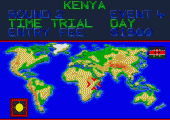
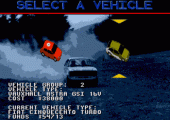
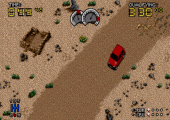
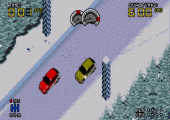
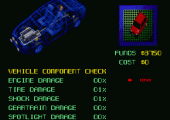
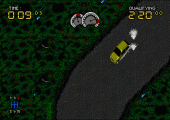
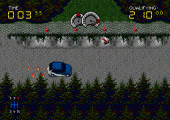
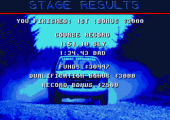
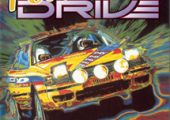
An excellent title. The difficulty ramps up after about the third stage, forcing you to consider how to manage your funds on repairs and then trying like hell not to damage your car too much, otherwise its game over.
You will keep returning to this game however, once the frustration dies down, and considering the mega drive was not a console famed for its driving games, Power Drive stands out.
Plus an eye catching box art cover to boot, its a must for any collector.